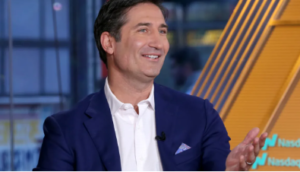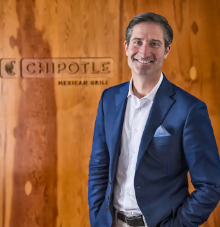URL: starbucks-brian-niccol-85-million-ceo-compensation-package
Description:
Starbucks lures Brian Niccol from Chipotle with an $85 million compensation package as the new CEO. Discover the details and what it means for the coffee giant’s future.
Starbucks has made a bold move to rejuvenate its business by hiring Brian Niccol, the former CEO of Chipotle Mexican Grill, as its new Chief Executive Officer and Chair. Niccol, renowned for his success in transforming Chipotle’s fortunes, will officially join Starbucks on September 9, 2024. To secure his leadership, Starbucks has offered Niccol a massive $85 million compensation package.

Details of Niccol’s Compensation:
- Base Salary: Niccol will earn an annual base salary of $1.6 million.
- Cash Bonuses: He has the potential to receive up to $7.2 million in additional cash bonuses, contingent on the company’s performance.
- Equity Awards: The majority of his package includes $75 million in equity awards, which will vest over three to four years based on Starbucks’ performance metrics and Niccol’s tenure.
- Signing Bonus: To compensate for his departure from Chipotle, Niccol will receive a $10 million cash bonus.
In his first year at Starbucks, Niccol’s total compensation could reach an astounding $116.8 million if all performance targets are met.
Challenges and Expectations: Niccol steps into the role at a pivotal time for Starbucks. The company has been facing declining sales, challenges in the Chinese market, and the need to improve the overall customer experience. Niccol’s proven track record at Chipotle, where he led the company to a 773% increase in stock value, positions him as the ideal leader to spearhead Starbucks’ turnaround.
Starbucks’ Confidence in Niccol: “Brian Niccol has proven himself to be one of the most effective leaders in our industry, generating significant financial returns over many years,” Starbucks stated. “His compensation is directly tied to Starbucks’ performance, ensuring that his success is aligned with that of our partners, customers, and shareholders.”
Comparison to Previous Leadership: Niccol’s compensation far exceeds that of his predecessor, Laxman Narasimhan, who earned a base salary of $1.3 million with potential cash bonuses up to $5.85 million and equity awards worth $13.6 million. Narasimhan’s total compensation for fiscal 2023 was $14.6 million.
Unlike Narasimhan, Niccol will not be required to relocate to Starbucks’ Seattle headquarters, giving him greater flexibility in his leadership approach.
Impact on Starbucks and the Industry: Niccol’s appointment is expected to have a significant impact on Starbucks’ future. With his leadership, the company aims to regain its competitive edge, particularly in global markets like China. Niccol’s departure from Chipotle also marks a major shift in the fast-casual restaurant industry, where he was instrumental in driving growth and enhancing brand reputation.
As Niccol prepares to take the helm, all eyes will be on how his strategies will shape the future of Starbucks and whether he can replicate the success he achieved at Chipotle.
- Turnaround Strategy at Chipotle: Detail the specific strategies Niccol implemented to revive Chipotle, such as menu innovation, digital expansion, and customer engagement initiatives. Mention key milestones like the introduction of digital ordering, Chipotle’s rewards program, and new menu items that boosted sales.
- Financial Performance: Provide figures on Chipotle’s financial growth during Niccol’s tenure, including revenue growth, profit margins, and stock performance. Highlight how Niccol’s leadership increased the company’s market capitalization.
Chanllenges
Declining Sales: Include data on Starbucks’ recent sales trends, particularly in North America and China, with figures showing year-over-year performance. Discuss specific factors contributing to these declines, such as changing consumer preferences, increased competition, and economic conditions in key markets.
- China Market Struggles: Offer more detail on Starbucks’ challenges in China, including competition from local coffee chains, the impact of COVID-19 restrictions, and the economic slowdown. Provide recent sales figures from Starbucks’ China operations and compare them with previous years.
- Customer Experience Issues: Include customer feedback or survey data highlighting areas where Starbucks has struggled, such as store cleanliness, service speed, or mobile app performance.
3. Niccol’s Compensation in Context
- Comparison with Other CEOs: Compare Niccol’s compensation package with those of other top CEOs in the industry, such as Howard Schultz (former Starbucks CEO), Kevin Johnson (Starbucks’ previous CEO), and executives at companies like McDonald’s, Dunkin’, and Restaurant Brands International.
- Incentive Structure: Break down how Niccol’s equity awards are structured, including the specific performance metrics (e.g., revenue growth, profit margins, market share) that will determine the vesting of his stock options. Explain the rationale behind offering such a large equity component in his compensation.
- Digital Transformation: Discuss Starbucks’ plans to further enhance its digital offerings, including mobile ordering, delivery services, and loyalty programs. Provide data on the growth of Starbucks Rewards membership and its impact on sales.
- Sustainability Initiatives: Outline any sustainability goals that Niccol might prioritize, such as reducing Starbucks’ carbon footprint, expanding its plant-based menu options, or enhancing its ethical sourcing practices.
- Global Expansion: Detail any plans Starbucks has for expanding into new markets or growing its presence in existing ones, especially in Asia and Europe. Include information on potential store openings, partnerships, or joint ventures.
- Stock Market Response: Provide data on how Starbucks’ stock has responded to the news of Niccol’s appointment, including any immediate changes in stock price and trading volume. Compare this with how Chipotle’s stock reacted to his departure.
- Analyst Predictions: Include quotes or summaries from financial analysts on how they expect Niccol’s leadership to impact Starbucks’ performance. Mention any changes in stock ratings, price targets, or earnings forecasts from major financial institutions.
- Customer Sentiment: Include quotes or data from customer surveys on what they expect from Starbucks under Niccol’s leadership. Highlight any concerns or areas of improvement that customers are looking forward to.
- Employee Morale: Discuss how Starbucks employees have reacted to the leadership change, including any statements from unions, employee groups, or company insiders. Mention any expectations employees have regarding changes in company culture, wages, or working conditions.
- Potential Risks: Outline potential risks Niccol might face, such as economic downturns, regulatory challenges, or shifts in consumer behavior. Discuss how these risks could impact Starbucks’ performance in the long term.
- Opportunities for Growth: Highlight areas where Starbucks could see growth under Niccol’s leadership, such as expanding its product offerings, leveraging technology, or entering new markets.
- Infographics:
- Create infographics showing the growth of Chipotle under Niccol’s leadership, Starbucks’ recent financial performance, and a breakdown of Niccol’s compensation package.
- Interactive Charts: Include interactive charts that allow readers to explore Starbucks’ stock performance, sales trends, and customer satisfaction metrics over time.





